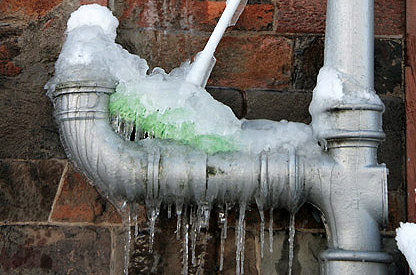We've noticed the article relating to How To Avoid Freezing Pipes listed below on the web and think it made sense to relate it with you on this site.

Winter can wreak havoc on your plumbing, particularly by freezing pipelines. Below's just how to avoid it from occurring and what to do if it does.
Introduction
As temperatures decline, the danger of frozen pipes increases, possibly bring about expensive repair work and water damages. Recognizing exactly how to stop icy pipes is critical for house owners in cold climates.
Recognizing Frozen Pipelines
What causes pipelines to freeze?
Pipelines ice up when subjected to temperature levels below 32 ° F (0 ° C) for expanded periods. As water inside the pipelines freezes, it broadens, putting pressure on the pipe wall surfaces and potentially triggering them to break.
Threats and damages
Icy pipelines can lead to supply of water disturbances, residential or commercial property damages, and pricey repairs. Burst pipes can flood homes and trigger substantial architectural damage.
Signs of Frozen Pipeline
Determining frozen pipes early can prevent them from bursting.
Exactly how to recognize frozen pipelines
Look for lowered water flow from taps, unusual odors or noises from pipes, and visible frost on exposed pipelines.
Avoidance Tips
Protecting prone pipes
Wrap pipelines in insulation sleeves or make use of warmth tape to secure them from freezing temperatures. Focus on pipelines in unheated or external areas of the home.
Heating methods
Keep indoor areas effectively heated up, especially locations with plumbing. Open up cupboard doors to allow cozy air to distribute around pipelines under sinks.
Securing Outdoor Pipes
Garden tubes and outdoor taps
Disconnect and drain pipes garden tubes before winter months. Install frost-proof faucets or cover exterior faucets with shielded caps.
What to Do If Your Pipes Freeze
Immediate actions to take
If you believe frozen pipes, maintain faucets available to soothe pressure as the ice melts. Utilize a hairdryer or towels taken in hot water to thaw pipes slowly.
Long-Term Solutions
Architectural adjustments
Consider rerouting pipes away from exterior wall surfaces or unheated locations. Include added insulation to attic rooms, cellars, and crawl spaces.
Updating insulation
Buy top quality insulation for pipes, attics, and walls. Appropriate insulation assists keep constant temperatures and lowers the risk of icy pipelines.
Conclusion
Avoiding frozen pipes needs proactive measures and quick responses. By understanding the reasons, indicators, and safety nets, home owners can secure their plumbing during winter.
5 Ways to Prevent Frozen Pipes
Drain Outdoor Faucets and Disconnect Hoses
First, close the shut-off valve that controls the flow of water in the pipe to your outdoor faucet. Then, head outside to disconnect and drain your hose and open the outdoor faucet to allow the water to completely drain out of the line. Turn off the faucet when done. Finally, head back to the shut-off valve and drain the remaining water inside the pipe into a bucket or container. Additionally, if you have a home irrigation system, you should consider hiring an expert to clear the system of water each year.
Insulate Pipes
One of the best and most cost-effective methods for preventing frozen water pipes is to wrap your pipes with insulation. This is especially important for areas in your home that aren’t exposed to heat, such as an attic. We suggest using foam sleeves, which can typically be found at your local hardware store.
Keep Heat Running at 65
Your pipes are located inside your walls, and the temperature there is much colder than the rest of the house. To prevent your pipes from freezing, The Insurance Information Institute suggests that you keep your home heated to at least 65 degrees, even when traveling. You may want to invest in smart devices that can keep an eye on the temperature in your home while you’re away.
Leave Water Dripping
Moving water — even a small trickle — can prevent ice from forming inside your pipes. When freezing temps are imminent, start a drip of water from all faucets that serve exposed pipes. Leaving a few faucets running will also help relieve pressure inside the pipes and help prevent a rupture if the water inside freezes.
Open Cupboard Doors
Warm your kitchen and bathroom pipes by opening cupboards and vanities. You should also leave your interior doors ajar to help warm air circulate evenly throughout your home.

As a keen reader about Helpful Tips to Prevent Frozen Pipes this Winter, I assumed sharing that information was a good thing. Are you aware of another person who is serious about the subject? Feel free to share it. Thanks for your time. Kindly stop by our blog back soon.
Set An Appointment
Comments on “Ways to Prevent Frozen Plumbing in Winter: Expert Guidance”